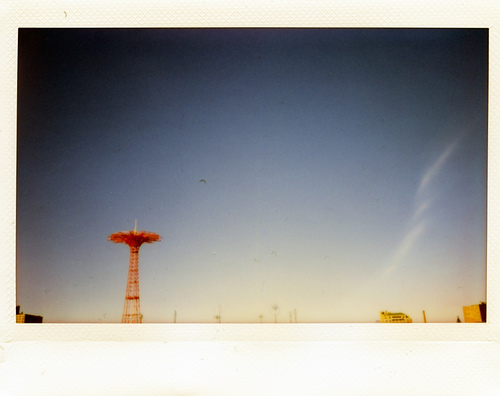The “New Polaroidâ€
The reaction to Polaroid’s discontinuation of its instant camera line was swift and charged. (Polaroid has since modified its decision.) People clamored and cried for the nostalgia of instant analog images of old, and the Impossible Project (with the help of Urban Outfitters) has started inventing a new film compatible with vintage Polaroid cameras due out by 2010. Fujifilm must’ve caught a whiff of this, because POOF we’ve been granted the Fujifilm version '“ Fuji Instax.
For under $50, you can buy the Fuji Instax 200 '“ a Fisher Price-esque wide-screen instant camera. Weighing almost 2 lbs, this camera makes up for it’s awkward bulk by being totally fun! Film can be found for about $.75 a shot, which makes this the most affordable instant camera available today. The picture quality is a little blurry, but the colors are vibrant and appropriately 'œemotion evoking' to draw in many of the discontent ex-Polaroid crowd.
Riding the wave of success of the Instax 200, Fuji recently released the Instax MINI 7S. A little cuter, a little kitschier, and about half the size, the MINI prints credit card sized shots (costing the high price of almost $2 each). While the design and limited edition colors (choco or white) are adorable, the finished product is a little too small for my taste. Still, blogs and articles have popped up all over the place praising the MINI, hailing it as the gift to give this holiday season.
Taking a completely different approach to the loss of Polaroid instants, a cute little fellow named Paul Ladroid (ha) created a FREE mac and pc Poladroid application where people can turn their digital photos into digital Polaroids '“ thumb prints, color warping, scratches, and all! (You can download it here.)
So this brings me to my question. What’s all this fuss about instant pictures? When picture qualities have become clear, sharp, and vibrant, and when computers are found in practically every household in America, why are we still willing to pay between $.75 and $2 for a piece of plastic and film?
It might have to do something with the way we see our world. When I look around, I don’t just see the objects and colors in front of me. My vision is affected by my emotions, sensory perceptions, and past memories. In a unique way, a Polaroid, is flawed and subjective just like us. Digital cameras capture the facts, but my complex and muddy reality is more than that. A Polaroid captures the world as I remember it, as ever changing and relative.
A Polaroid is also about that one picture. The image emerges from the whiteness directly before your eyes, and you know that only one of those images exists. You don’t have to rely on downloading and cropping and editing and adjusting. Emailing, uploading, tagging, or naming. Each picture communicates a story that lives solely inside its white frame. It is private. It is simple. It is instant tangible satisfaction.
While instant cameras are not exactly cheap, I don’t think that’s their purpose. With the unlimited digital world we live in, there is something super refreshing about having only a certain number of shots. I think people are drawn to instant cameras because of their finite quality. Once you’re out of film, you’re out. You are released from the temptation of continuing to interact with the world through the lens of a camera. You are free to just live.
DIY Project – Make an Instant Photo Frame
After all the shots have been taken, remove the empty film case from the camera.
Super glue a magnet to the back of the old film case.
Decorate the front of the film case with feathers and small objects if desired.
Tape your favorite instant photo inside the newly created 'œframe.'
Stick on the fridge.
Enjoy!



